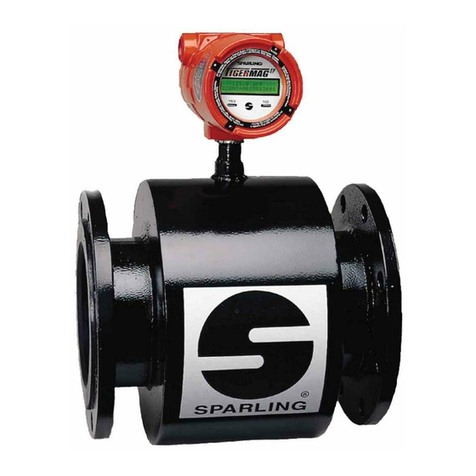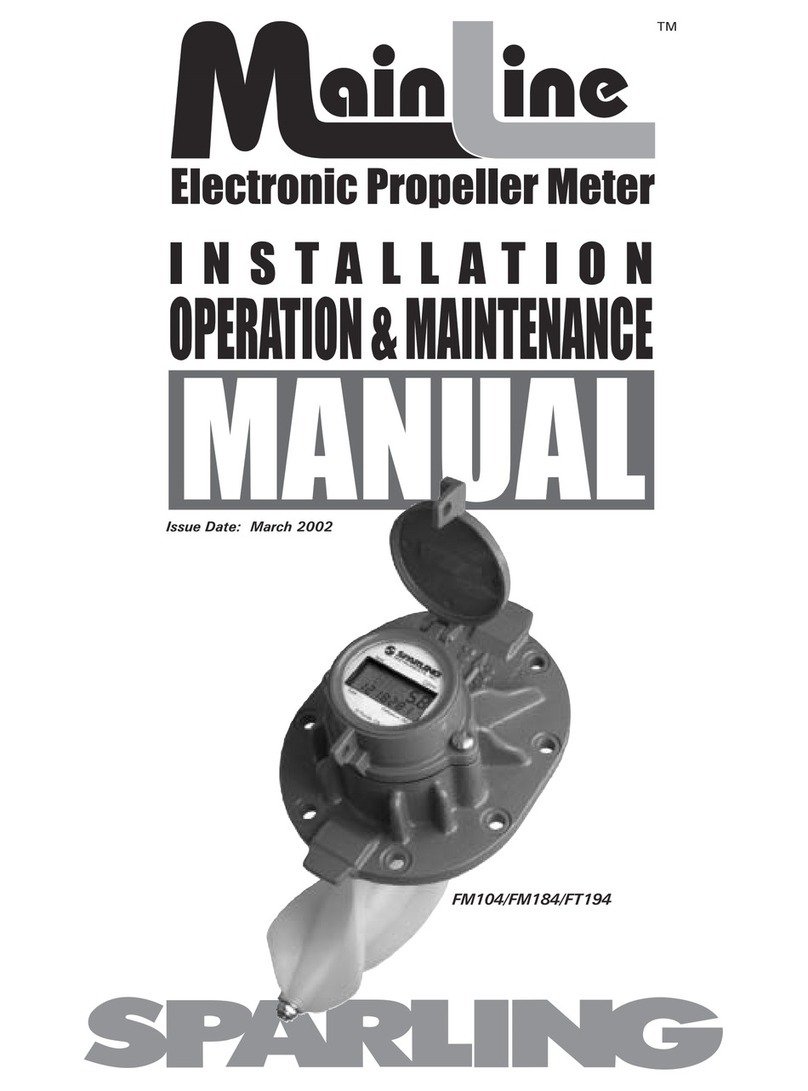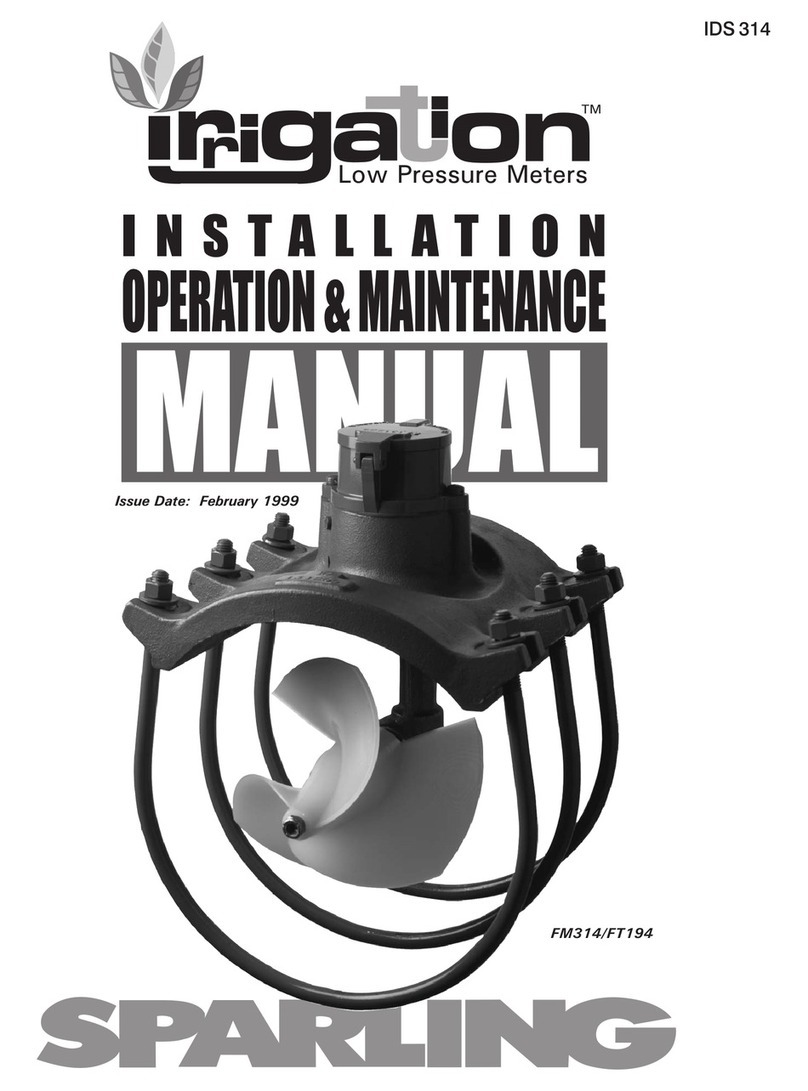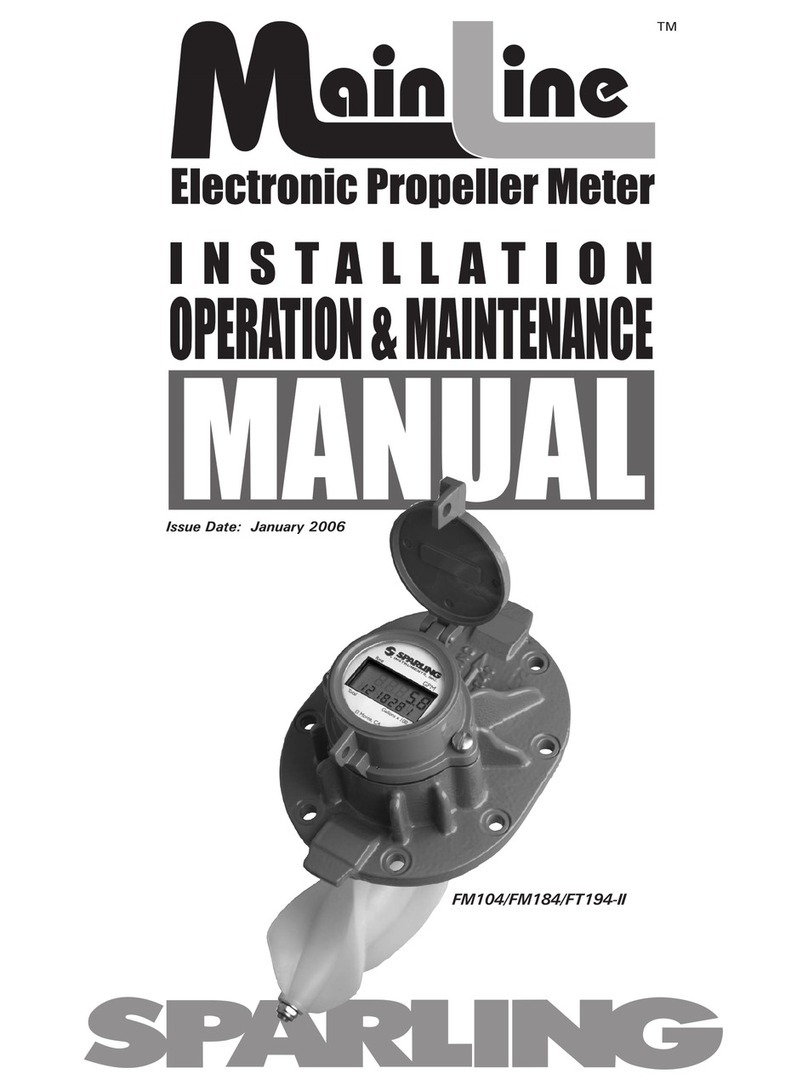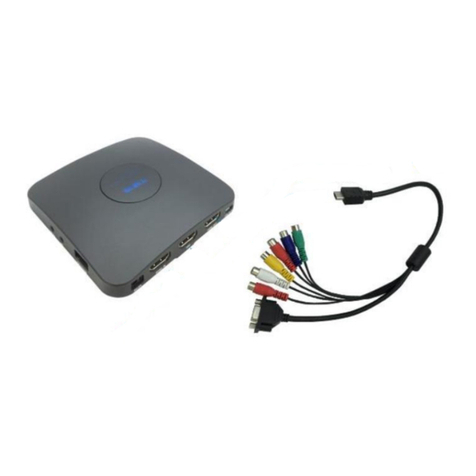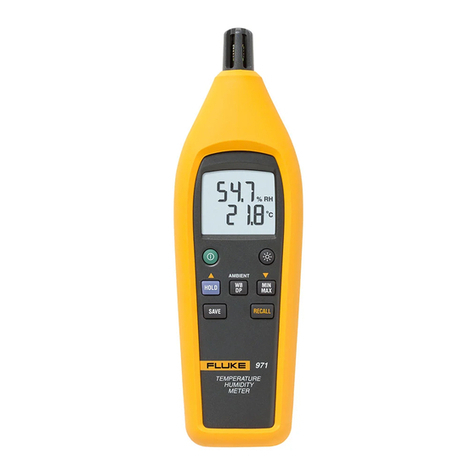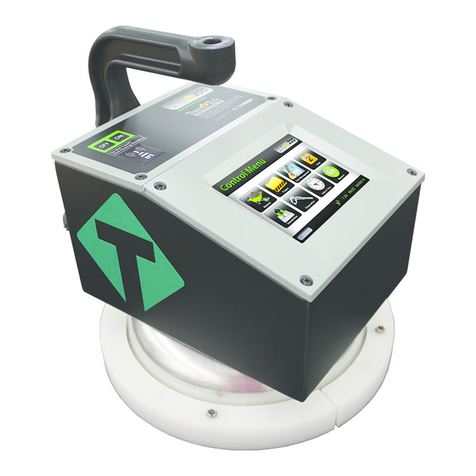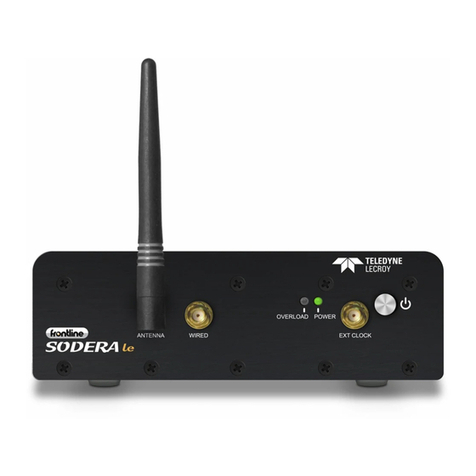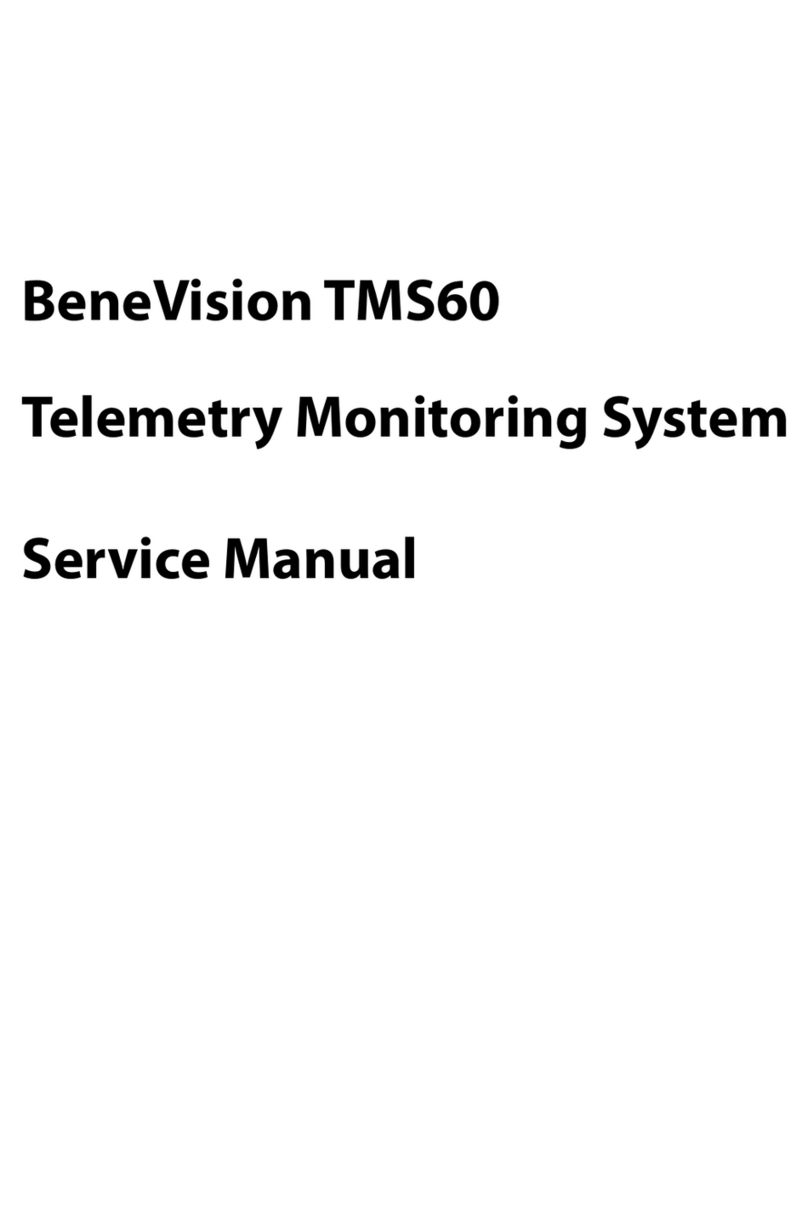SPARLING Tigermag FM656 Instruction manual

Issue Date: March 2002
FM626 Sanitary
FM627
FM626
FM657
FM656
All manuals and user guides at all-guides.com

All manuals and user guides at all-guides.com

IDS-626/627/656/657 Page i
TABLE OF
CONTENTS
Page
SECTION 1 - GENERAL ..............................1
1.1 Measuring System ........................................ 1
1.2 Operating Principal ........................................ 1
1.3 Application to Magnetic Flow
Measurement ................................................ 1
1.4 Interference ................................................... 2
1.5 System Operation ......................................... 3
1. Construction .................................................. 4
1.7 Specifications ................................................ 5
1.8 Interchangeability ........................................... 7
1.9 Flow Rates, Dimensions & Weight ................. 7
SECTION 2 - PRE-INSTALLATION ..... 10
2.1 Receiving and Inspection ............................ 10
2.2 Storage ....................................................... 10
2.3 Return of Equipment .................................... 10
SECTION 3 - INSTALLATION ............... 11
3.1 Application Considerations .......................... 11
3.2 Site Selection ............................................... 11
3.3 Rotating the Transmitter Display .................. 12
3.4 Removable Electrodes ................................ 13
3.5 Hot-Tap Removable Electrodes .................. 13
3. Pipe Connections ........................................ 15
3.7 Special Mounting Bolts & Gaskets ........... 1
3.8 Grounding ................................................... 20
3.9 Electrical Connections ................................. 21
3.10 Remote Mounted Transmitter ...................... 24
3.11 Lightening Protection ................................... 28
SECTION 4 - START-UP ......................... 28
4.1 Start-Up Procedure ..................................... 28
SECTION 5 - CALIBRATION.................. 28
5.1 Calibration ................................................... 28
SECTION 6 - MAINTENANCE ............... 29
SECTION 7 - TROUBLESHOOTING ... 29
7.1 General ........................................................ 29
7.2 Troubleshooting Chart ................................. 29
7.3 Electronics Self Test ..................................... 31
7.4 Electronics Module Replacement ................ 31
7.5 Sensor Testing ............................................ 32
7. Coil Continuity Testing ................................. 33
7.7 Coil Insulation Test ....................................... 33
Page
7.8 Electrode Circuit Insulation Test ................... 33
SECTION 8 – REPLACEMENT PARTS
LIST ...................................................... 34
APPENDIX 1- PROGRAMMING......... 35
1.1 General ..................................................... 35
1.2 Entering Data ............................................. 35
1.3 Batching Modes ........................................ 3
1.4 Show Meter Data ....................................... 3
1.5 Password Entry......................................... 3
1. Rescale Rate ............................................. 37
1. .1 Select Rate Units ....................................... 37
1. .2 Set Full Scale ............................................. 38
1. .3 Select Rate as % of Full Scale ................... 38
1.7 Rescale Total ............................................. 38
1.7.0 Lockout ..................................................... 38
1.7.1 Alarms ....................................................... 39
1.7.2 Count Direction .......................................... 39
1.7.3 Select Total Units ....................................... 39
1.7.4 Set Registration ......................................... 40
1.7.5 Reset Totalizer .......................................... 40
1.8 Set Outputs ............................................... 40
1.8.1 Select Pulse Width ..................................... 40
1.8.2 Backlight ................................................... 41
1.8.3 Set Flow Direction ..................................... 41
1.8.4 Empty Pipe Detection................................ 41
1.8.5 Protocol .................................................... 41
1.9 Damping Adjustments .............................. 42
1.9.1 Display Damping ....................................... 42
1.9.2 Current Damping ....................................... 42
1.9.3 Low Flow Cutoff ........................................ 42
2.0 Exit Programming ..................................... 42
2.1 Change Password..................................... 42
2.2 Change Tag............................................... 43
2.3 Diagnostics ............................................... 43
2.3.1 Check HART Transmission ....................... 43
Check Coil Current .................................... 43
2.3.2 Check Current Loop ................................. 44
2.3.3 Calibrate 4-20mA Loop ............................. 44
2.3.4 Set Frequency ........................................... 44
2.3.5 Simulate 75% FS ....................................... 45
2.3. Simulator Check ........................................ 45
All manuals and user guides at all-guides.com

Page ii TigermagEP™
TABLE OF
CONTENTS
cont'd.
Page
APPENDIX 2 - Batch Programming
and Operation................................ 46
1.1 General ..................................................... 4
1.2 Programming ............................................ 4
1.2.0 Lockout ..................................................... 4
1.3 Rescale Total ............................................. 47
1.3.1 Batch On/Off ............................................. 47
1.3.2 Alarms ....................................................... 47
1.3.3 Count Direction .......................................... 47
1.3.4 Select Total Units ....................................... 48
1.3.5 User Defined Totalizer Units ...................... 48
Conversion Factor .................................... 48
1.4.1 Description of Operating ........................... 49
APPENDIX 3 - Communication .......... 50
1.1 RS232 Sparling Protocol ............................. 50
1.2 RS485 ......................................................... 51
FIGURES
1.1 Measuring Principal ..................................... 1
1.2 Block Diagram ............................................ 3
1.3 Dimensions ................................................. 8
3.1 Full Pipe Required ..................................... 11
3.2 Changing the Rotatable Display ................ 12
3.4 Hot Tap Electrode ..................................... 13
3.5 Removing the Electrode ........................... 14
3. FM 2 Gasket Installation ......................... 18
3.7 FM 2 Sensor Position ............................. 18
3.8 FM 5 Gasket Installation ......................... 19
3.9 FM 5 Sensor Position ............................. 19
3.10 Grounding ................................................. 20
3.11 Conduit Connections ................................ 21
3.12 Electrical Connections I/O PCB................. 22
3.13 Installing Diode Across
Inductive Loads ......................................... 23
3.14 TigermagEP Remote Display .................... 24
Page
FIGURES cont'd.
3.15 TigermagEP Remote Conduit
Connections .............................................. 24
3.1 TigermagEP Standard
Motherboard ............................................. 25
3.17 Remote Mounted Transmitter ................... 27
4.1 Power Supply Voltage Ratings ................. 28
7.1 Access to Electronics................................ 31
7.2 Removing the Electronics Module ............ 31
7.3 Aligning Electronics Module
with Card Guides ....................................... 32
7.4 Replacing the E2PROM Chip ..................... 32
7.5 Coil Resistance Testing ............................. 33
7. Coil Insulation Testing................................ 33
7.7 Electrode Circuit Insulation Test ................ 33
A1.1 TigermagEP Display ................................. 35
A1.2 Main Program ........................................... 3
A1.3 Rescale Rate Flow Chart ........................... 37
A1.4 Rescale Total Flow Chart........................... 38
A1.5 Set Outputs Flow Chart ............................. 40
A1. Connecting HART Communicator ............. 41
A1.7 Set Damping Flow Chart ........................... 42
A1.8 Change Tag ............................................... 43
A1.9 Diagnostics Flow Chart ............................. 43
A2.0 Simulate Mode .......................................... 45
A2.1 Enclosure for TigermagEP
with Batching ............................................. 4
A2.2 Rescale Rate w/Batcher
Flowchart .................................................. 47
TABLES
1. Nominal Flow Rates ...................................... 7
2. Weight ........................................................... 7
3. Dimensions ................................................... 9
4. Gasket Material ........................................... 15
5. Meter I.D. .................................................... 1
. Torque, Flange & Bolt
Specifications .............................................. 17
All manuals and user guides at all-guides.com

IDS-626/627/656/657 Page 1
1.0
General
In a magnetic flowmeter the liquid acts as a moving conductor as it flows through the pipe. The induced
voltage (E) in the liquid is measured by two sensing electrodes mounted opposite each other in the
meter sensing head.
The length of the conductor is equal to the distance between sensing electrodes and also the internal
diameter (D) of the pipe. The flux density is proportional to the coil current (I), times a constant (k).
The above formula can be restated as follows:
E = I x k x D x V
flow Q
V = cross sectional area =A
E = Q x I x 4 x k
D2
1.3
Application
to Magnetic
Flow
Measurement
Measuring Principle
Figure 1.1
Operating
Principle
1.2
Operation is based on Faradays Law of Mag-
netic Induction. An electrically conductive liquid
flowing through a magnetic field induces a volt-
age which is perpendicular to this field and to the
direction of the flow. This voltage is proportional
to the average flow velocity. See Figure 1.1.
The mathematical formula describing Faradays
law reads:
E = B x L x V
E = Induced voltage
B = Magnetic field intensity (flux density)
L = Distance between the electrodes
(pipe diameter)
V = Average flow velocity of liquid
The Sparling TigermagEPTM Model FM- 2 , FM 27, FM- 5 and FM- 57 flowmeters are obstructionless
devices for monitoring the volumetric flow of conductive liquids in full closed pipes.
The flowmeter consists of a sensor (wafer or flanged) with a nonmagnetic liner, sensing electrodes and
a measuring transmitter.
1.1
Measuring
System
Note that if I is held constant, E is proportional to Q or the induced voltage is directly proportional to
the average flow rate (V).
All manuals and user guides at all-guides.com

Page 2 TigermagEP™
1.4.1 ElectrochemicalInterference
The signal voltage is measured by two electrodes. Galvanic elements form on the surface areas
between the ion-conducting liquid and the metal electrodes. The polarization voltages which result
are dependent on temperature, pressure, and the chemical composition of the electrodes and liquid.
These are direct voltages which cannot be predicted and which can be different at each electrode.
The signal voltage must be separated from the interference direct voltage. Proper grounding
eliminates these unpredictable voltages from interfering with the signal voltage.
1.4.2 InductionInterference(Quadrature)
Electrode cables connect the electrodes with the meter electronics. Because these cables must run
within the magnetic field, a voltage is induced which is proportional to the rate of change of the
magnetic field strength. The meter design minimizes the length of conductor within the magnetic field
in order to keep the value of this interference as low as possible.
1.4.3 OtherInterferenceVoltages
Pipes and the liquids within them are often used as a conductor for electrical grounding. This creates
a voltage potential between electrodes which can be high relative to the signal voltage. Proper
grounding of the flowmeter to the liquid is necessary to achieve correct meter operation. Grounding
rings should be installed if the flowing medium has a voltage potential, if piping is nonconductive
(plastic or lined) or if conductivity is below 20 micromhos/cm. See Section 3.8 Grounding.
1.4
Interference
All manuals and user guides at all-guides.com

IDS-626/627/656/657 Page 3
1.5
System
Operation
The Sparling TigermagEP uses the autozeroing, bipolar, pulsed-DC measuring technique. The
circuitry (Fig. 1.2) energizes the coil with 300 mA typical current at a frequency of up to 100 Hz. The
signal generated at the electrodes is measured near the end of each measuring cycle to eliminate the
capacitive effects of coatings. The Hi-Z (1012 Ω) input impedance eliminates the resistive effects of
electrode coatings. The field current alternates to a positive and negative state and the two measured
signals are averaged to eliminate the effect of a zero offsetthis is the auto-zeroing feature.
1. Measuring Sensor . Sample and Hold 11. Adjustable Empty Pipe 14. LCD Display with Hall-Effect
2. Electrode Cable PCB 7. Voltage to Frequency Converter Detection (in software) Switches
3. Input Amplifier 8. Nonvolatile E2PROM (constants) 12. Watchdog Timer 15. Optocouplers
4. Summing Point 9. Coil Current Multiplexer 13. Microcontroller 1 . Frequency to Current Converter
5. Autozero Circuit 10. Built-in Simulator 17. Power Supply Section
Block Diagram
Figure 1.2
All manuals and user guides at all-guides.com

Page 4 TigermagEP™
1.6.1 Sensor
The FM626 is a wafer style meter. It is available with either a ceramic or optional Tefzel® liner. The
Tefzel® liner is rotamolded onto a stainless steel sensor tube. Both liners are press-fit into a carbon
steel housing. The FM627 is a wafer style meter. The flow sensor housing is made of steel with a
polyurethane liner. Sensor coils are completely encapsulated in polyurethane. The FM656 flow
sensor is a welded fabrication of 304 stainless steel, fitted with two carbon steel flanges. The flow
sensor contains a nonconductive liner of ceramic, polyurethane, Tefzel®, hard rubber, soft rubber,
or neoprene. The FM657 flow sensor housing is made of steel with a polyurethane liner. Sensor coils
are completely encapsulated in polyurethane. All TigermagEP meters are rugged, waterproof
assemblies capable of handling a wide range of highly corrosive and abrasive liquids.
Fused platinum electrodes, standard on ceramic meters from 0.1" to 2", require no O-rings,
eliminating the possibility of leaking. Platinum is suitable for nearly all conductive liquids. The
electrodes in all other liners are self-sealing.
All internal cavities of the FM- 2 sensor housing are filled with a high temperature silicone potting
compound to prevent the possibility of moisture damage and to avoid the possibility of collection
of explosive gases.
▼▼
▼▼
▼WHEN PROPERLY CONNECTED WITH LIQUID-TIGHT CONDUIT, THE FM626 AND FM627 REMOTE
FLOW SENSOR WILL WITHSTAND ACCIDENTAL SUBMERGENCE. (SEE FIG. 3. 6 ON PAGE 25).
1.6.2 IntegralTransmitter
The transmitter is mounted on the meter body and housed in a NEMA-4X and NEMA-7 enclosure that is
approved by CSA and Factory Mutual. The power and signal electrical connections are made in a separate
section of the housing which is isolated from the electronics.
1.6.3 RemoteTransmitter
The transmitter is housed in a NEMA-4X enclosure some distance away from the meter body.
Remote mounting is recommended where pipe vibration is excessive or when flooding is
possible.
Remote mounting for the FM626 and FM656 is REQUIRED when high process tempera-
tures exist at high ambient temperatures (above 212° F/100° C). The FM 27 and FM 57 should
not be installed where process temperatures will exceed 180° F.
The optional remote mounting kit includes interconnecting cable between the sensor and
transmitter enclosure. The standard interconnecting cable length is 15 feet. Shorter or longer
cables should be specified when ordered from the factory. The cable may be shortened in the
field.
1.6
Construction
CACA
CACA
CAUTIONUTION
UTIONUTION
UTION
DO NOT MAKE CONNECTIONS WHILE
POWER IS APPLIED.
Disconnect Power Before Proceeding
All manuals and user guides at all-guides.com

IDS-626/627/656/657 Page 5
Po er Requirements See Nameplate
Fuses Slo-Blo (12- 0 Vdc).........................................................................2.0 amp
Slo-Blo (77-2 5 Vac) .......................................................................1.0 amp
Spare fuse provided on connector PCB.
Wire Size Power ...................................................................... 1 AWG; 14 AWG Max
Signal ............................................................................................... 18 AWG
Ground Cable Third wire ground of power cable
Accuracy 0.1" - 0.5"
(Frequency Output) 0.5% of span (1-3 fps)
0.25% of span (≤ 50% of span) (3-33 fps)
0.5% of flow rate (≥50% of span) (3-33 fps)
1.0" - 48.0"
0.25% of span (≤50% of span) (1-3 fps)
0.5% of flow rate (≥ 50% of span) (1-3 fps)
0.1% of span (≤20% of span) (3-33 fps)
0.5% of flow rate (≥ 20% of span) (3-33 fps)
Reference Conditions 25° C, fps full scale. Temperature effect, 0.025% Full Scale/°C.
Accuracy statement based on digital outputs
Repeatability Within ±0.1% full scale
Po er Consumption Less than 20 VA
Output Signals Simultaneous isolated analog and digital
(all referenced to the same isolated ground)
Analog: 0 to 20 or 4-20 mAdc into 800 ohms max.
Digital: Scaled pulse and frequency
a. Scaled, 24 Vdc pulse with 12.5/25/50/100 ms on-time,
0- 0 Hz max into 150 ohm impedance min.
b. Scaled frequency. 15 Vdc square wave, 50/50 duty cycle,
0-1000 Hz max into 1000 ohms min.
c. Fault, with open collector
d. All open collectors are rated (100mA at 30 Vdc)
e. RS232 Communication
Fault Open collector. Active on self test failure, empty pipe and during
programming, low/no coil drive and failure of external totalizer to keep
up with the flow (registration too small).
Input Signal Positive zero return (PZR). Connect to remote dry contact to drive
analog and digital outputs to zero when an empty pipe condition can
occur.
Minimum Conductivity 5 micromhos/cm
Flo Direction Open collector (rating: 100 mA at 30 Vdc). Active in reverse flow.
T o Flo Alarms Open collector. Relay option available in remote mounting only.
1.7
Specifications
All manuals and user guides at all-guides.com

Page 6 TigermagEP™
1.7
Specifications
Cont'd.
Full Scale
Velocity Ranges 0-3 to 0-33 fps (0-1 to 0-10 mps)
Ambient Temp Limits -20° to 140°F (-30° to 0 °C) (Display may darken above 158 °F)
Process Temp Integral Mount
Hard rubber, Soft rubber, Neoprene, Polyurethane ............. -40 - 180°F
Tefzel®, Ceramic: ................................................................. -40 - 212° F
Remote Mount (opt)
Hard rubber, Soft rubber, Neoprene, Polyurethane ............ -40 - 180° F
Tefzel® (to 300 psi), Ceramic: .............................................. -40 - 2 ° F
High Temp Coils (opt)
Tefzel® (to 100 psi): ............................................................. -40 - 300° F
Ceramic: .............................................................................. -40 - 420° F
Temperatures above 212°F (100° C) require mounting the electronics in a
remote location (max. distance 15 feet at liquid conductivity of 5 micro-
mhos and min. velocity of 1 fps).
Storage Temp Limits -20° to 140° F (-30° to 0° C)
Construction Metering Tube .......................................... Model 2 Steel, epoxy coated
Model 5 0.5"-4" Steel, epoxy coated
Model 5 - " - 72" 304 SS welded, epoxy coated
Model 27 - 1" - 8" Cast Ductile Iron, epoxy coated
Model 57 - 2" - 48" Fabricated Steel, epoxy coated
FlangesCarbon steel ANSI compatible
Lining ................................... Model 2 Aluminum Oxide 99.5% or Tefzel®
Mo d el 5 P ol y ur e t h an e , A l um i nu m Ox i de 9 9. 5%
Tefzel®, Hard Rubber, Soft Rubber, Neoprene
Model 27 & 57 Polyurethane
Electrodes .......................................................... 31 SS. Others as required
Integral Housing (XMTR) ................ Cast Aluminum, Hi-build Epoxy Coated
Remote Housing (XMTR) .............................................................Fiberglass
Protection rating
Integral ...................................................................NEMA-4X, NEMA-7
Remote ................................................................................. NEMA-4X
Electrical rating
Remote Mount - General Purpose
Integral Mount - azardous Locations
FM Approved* for Class I, Division 1, Groups B, C, D;
Class II Groups E, F, G
CE Approved (pending)
CSA Approved* for Class 1, Division 2, Groups A, B, C, D
*FM and CSA applies to integrally mounted transmitters up to 150 psi only.
All manuals and user guides at all-guides.com

IDS-626/627/656/657 Page 7
Nominal 2 (Ceramic/Tefzel)** 2 (Sanitary) 27 (Poly) 2 , 5 , 57 (others)
Meter Size ±.5% Min Max ±.5% Min Max ±.5% Min Max ±.5% Min Max
Inches mm 1 fps 3 fps 33 fps 1 fps 3 fps 33 fps 1 fps 3 fps 33 fps 1 fps 3 fps 33 fps
*0.1 2.5 0.04 0.1 1.3 N/A N/A N/A N/A N/A N/A N/A N/A N/A
*0.25 0.22 0. 7.2 N/A N/A N/A N/A N/A N/A N/A N/A N/A
*0.5 12 0.50 1.5 1 N/A N/A N/A N/A N/A N/A 0. 1.7 18
1.0 25 1. 2 4 53 1.3 4 42 1. 4.8 53 2
1.5 40 4 13 145 3.7 11 120 N/A N/A N/A 5 15 174
2.0 50 7 21 231 7.2 22 239 7 21 231 9 27 303
2.5 5 N/A N/A N/A 12 3 398 N/A N/A N/A N/A N/A N/A
3.0 80 N/A N/A N/A 1854598200 020 0 4
4.0 100 N/A N/A N/A 33 99 1088 35 105 1155 35 107 1182
.0 150 N/A N/A N/A N/A N/A N/A 88 2 4 2910 85 254 2800
8.0 200 N/A N/A N/A N/A N/A N/A 147 441 4851 145 43 4800
10.0 250 N/A N/A N/A N/A N/A N/A N/A N/A N/A 23 709 7800
12.0 300 N/A N/A N/A N/A N/A N/A N/A N/A N/A 333 1000 11000
14.0 350 N/A N/A N/A N/A N/A N/A N/A N/A N/A 409 1227 13500
1 .0 400 N/A N/A N/A N/A N/A N/A N/A N/A N/A 545 1 3 18000
18.0 450 N/A N/A N/A N/A N/A N/A N/A N/A N/A 7 2000 22000
20.0 500 N/A N/A N/A N/A N/A N/A N/A N/A N/A 879 2 3 29000
24.0 00 N/A N/A N/A N/A N/A N/A N/A N/A N/A 1273 3818 42000
30.0 750 N/A N/A N/A N/A N/A N/A N/A N/A N/A 1909 5727 3000
3 .0 900 N/A N/A N/A N/A N/A N/A N/A N/A N/A 2925 8775 9 525
42.0 1050 N/A N/A N/A N/A N/A N/A N/A N/A N/A 4040 12120 133320
48.0 1200 N/A N/A N/A N/A N/A N/A N/A N/A N/A 5322 159 175 2
54.0 1350 N/A N/A N/A N/A N/A N/A N/A N/A N/A 7144 21433 235800
0.0 1500 N/A N/A N/A N/A N/A N/A N/A N/A N/A 8500 25500 280500
.0 1 50 N/A N/A N/A N/A N/A N/A N/A N/A N/A 10300 31000 341000
72.0 1800 N/A N/A N/A N/A N/A N/A N/A N/A N/A 12700 38100 419100
The TigermagEP transmitter is designed to be used with any FM626, FM627, FM656 o r FM657 sensor.
Electronics are completely interchangeable. Meter identification (tube ID, Serial Number, K, Offset, etc.)
is stored on an E2PROM chip independent of transmitter electronics. This provides universal compatibility
b e t w e e n al l T i ge r m a g E P e le c t r on i c s m o d u le s , e li m i nating the need for reprogramming when switching
modules. FM656 (0.5"- 4"), FM627 (1"-4") and FM657 (2"-4") sizes have the same face-to-face
dimensions as FM626 wafer-style meters (0.5"- 4"). See Figure 1.3
1.8
Interchange-
ability
Nominal Meter Size 2 27 5 57
inches mm lbs kg lbs kg lbs kg lbs kg
0.1 2.5 15 7 N/A N/A N/A N/A N/A N/A
0.25 15 7 N/A N/A N/A N/A N/A N/A
0.512157N/A N/A 18 8 N/A N/A
1.025157157209N/A N/A
1.540209N/A N/A 2 12 N/A N/A
2.05020920930143014
2.5 5209N/A N/A N/A N/A N/A N/A
3.0 80 3014 3014 4822 4822
4.0 100 35 1 35 1 55 25 55 25
.0 150 N/A N/A 4 21 75 34 75 34
8.0 200 N/A N/A 49 22 105 77 105 77
10.0 250 N/A N/A N/A N/A 155 8 155 8
12.0 300 N/A N/A N/A N/A 235 117 235 117
14.0 350 N/A N/A N/A N/A 3 5 140 3 5 140
1 .0 400 N/A N/A N/A N/A 4 0 182 4 0 182
18.0 450 N/A N/A N/A N/A 555 209 555 209
20.0 500 N/A N/A N/A N/A 25 250 25 250
24.0 00 N/A N/A N/A N/A 8 0 33 8 0 33
30.0 750 N/A N/A N/A N/A 1325 432 1325 432
3 .0 900 N/A N/A N/A N/A 1800 48 1800 48
42.0 1050 N/A N/A N/A N/A 2280 818 2280 818
48.0 1200 N/A N/A N/A N/A 3500 977 3500 977
T ble 2 Weight
**Ceramic liners are slightly smaller than Tefzel. Flow rates for Tefzel lined meters from .5" to 2" ID's are
slightly higher than shown in Table 1 (above). Refer to PDS- 2 for actual numbers.
1.9
Flow Rates,
Dimensions
& Weight
*On meters
smaller than 1"
accuracy is
±1% of rate*
T ble 1 Nomin l Flow R tes (Full Sc le GPM)
All manuals and user guides at all-guides.com

Page 8 TigermagEP™
1.9
Flow Rates,
Dimensions
& Weight
cont'd.
Dimensions
Figure1.3
Integr l
Remote
2 -S
2 -S
27
27 5
5 57
2
2
57
All manuals and user guides at all-guides.com

IDS-626/627/656/657 Page 9
1.9
Flow Rates,
Dimensions
& Weight
cont'd.
Nominal Dimensions (Inches)
Meter Size A B C D
Inches mm *All 626-S 627 626 626-S 627 656 657 626 626-S 627 656 657 626 626-S 627 656 657
0.1 2.5 4.00 N/A N/A 2.31 N/A N/A N/A N/A 8.75 N/A N/A N/A N/A 8.50 N/A N/A N/A N/A
0.25 4.00 N/A N/A 2.31 N/A N/A N/A N/A 8.75 N/A N/A N/A N/A 8.50 N/A N/A N/A N/A
0.5 12 4.00 N/A N/A 2.31 N/A N/A 3.50 N/A 8.75 N/A N/A 9.50 N/A 8.50 N/A N/A 9.25 N/A
1.0 25 4.00 4.12 4.00 2.92 2.375 2.92 4.25 N/A 9.38 9.125 10.2 10.19 N/A 9.13 7.88 9.9 9.94 N/A
1.5 40 4.00 4.12 N/A 3. 2 3.50 N/A 5.00 N/A 10.00 10.25 N/A 10.88 N/A 9.75 9.00 N/A 10. 3 N/A
2.0 50 4.00 4.12 4.00 4.12 3.50 4.25 .00 .00 10. 3 10.25 11.8 11. 9 11.25 10.38 9.00 11.5 11.44 11.00
2.5 5 N/A 4.12 N/A N/A 4.00 N/A N/A N/A N/A 10.75 N/A N/A N/A N/A 9.50 N/A N/A N/A
3.0 80 .00 8.00 .00 5.70 4.50 5.40 7.50 7.50 11.75 11.25 13.4 13.00 13.00 11.50 10.00 13.1 12.75 12.75
4.0 100 .00 8.00 .00 . 0 . 25 . 0 9.00 9.00 13.00 13.375 14.9 14.38 14.38 12.75 12.12 14. 14.13 14.13
.0 150 13.38 N/A 8.00 N/A N/A 9.00 11.00 11.00 N/A N/A 17.3 17.00 1 .25 N/A N/A 17.0 1 .75 1 .00
8.0 200 13.38 N/A 8.00 N/A N/A 10.70 13.50 13.50 N/A N/A 19.4 19.40 18.50 N/A N/A 19.1 19.15 18.25
10.0 250 18.15 N/A N/A N/A N/A N/A 1 .00 1 .00 N/A N/A N/A 22.5 20.75 N/A N/A N/A 22.31 20.50
12.0 300 19.40 N/A N/A N/A N/A N/A 19.00 19.00 N/A N/A N/A 25.00 23.25 N/A N/A N/A 24.75 23.00
14.0 350 21.38 N/A N/A N/A N/A N/A 21.00 21.00 N/A N/A N/A 2 . 7 25.25 N/A N/A N/A 2 .42 25.00
1 .0 400 23.38 N/A N/A N/A N/A N/A 23.50 23.50 N/A N/A N/A 28.97 27.50 N/A N/A N/A 28.72 27.25
18.0 450 27.25 N/A N/A N/A N/A N/A 25.00 25.00 N/A N/A N/A 31.14 29.25 N/A N/A N/A 30.89 29.00
20.0 500 27. 3 N/A N/A N/A N/A N/A 27.50 27.50 N/A N/A N/A 33.39 31.50 N/A N/A N/A 33.14 31.25
24.0 00 32.75 N/A N/A N/A N/A N/A 32.00 32.00 N/A N/A N/A 37.44 35.75 N/A N/A N/A 37.19 35.50
30.0 750 43.50 N/A N/A N/A N/A N/A 38.75 38.75 N/A N/A N/A 43.72 42.13 N/A N/A N/A 43.47 41.88
3 .0 900 47.75 N/A N/A N/A N/A N/A 4 .00 4 .00 N/A N/A N/A 50.20 48.75 N/A N/A N/A 49.95 48.50
42.0 1050 51.75 N/A N/A N/A N/A N/A 53.00 53.00 N/A N/A N/A 5 .90 55.25 N/A N/A N/A 5 . 5 55.00
48.0 1200 51.75 N/A N/A N/A N/A N/A 59.50 59.50 N/A N/A N/A 3.05 1.50 N/A N/A N/A 2.80 1.25
54.0 1350 53.50 N/A N/A N/A N/A N/A .25 N/A N/A N/A N/A 9.88 N/A N/A N/A N/A 9. 3 N/A
0.0 1500 5.50 N/A N/A N/A N/A N/A 73.00 N/A N/A N/A N/A 7 .75 N/A N/A N/A N/A 7 .50 N/A
.0 1 50 5.50 N/A N/A N/A N/A N/A 80.00 N/A N/A N/A N/A 83.75 N/A N/A N/A N/A 83.50 N/A
72.0 1800 72.75 N/A N/A N/A N/A N/A 8 .50 N/A N/A N/A N/A 90.00 N/A N/A N/A NA 89.75 N/A
T ble 3 Dimensions
Note 1: Dimensions and chart values for 150 lb. flanges (ANSI template).
Note 2: Allow 1/4" for 0.5 to " meters and 1/2" for 8" and larger meters for grounding rings and gaskets.
Note 3: "C" & "D" Dimensions ±0.125"
All manuals and user guides at all-guides.com

Page 10 TigermagEP™
2.0
Pre-Installation
2.3
Returnof
Equipment
2.1
Receivingand
Inspection
2.2
Storage
When the equipment is received, the outside of the package should be inspected for damage. If any
damage or shortage is found, notation to that effect should be made on the carriers delivery receipt.
Visually inspect the sensor and transmitter for damage from rough handling or faulty packaging. If
concealed damage is discovered, notify the delivering carrier at once and request an inspection.
Confirm telephone conversations in writing. If inspection is not made, prepare an affidavit stating that
you notified the transportation company and that they failed to inspect. Save containers and
packaging material.
It is essential that the carrier be notified within 15 days from the date of delivery in order to be in a
position to present your claim. Make your claim promptly.
Unpacking and handling of TigermagEP Magnetic Flowmeters should be consistent with the
procedures used to handle field instruments.
When meter is returned to our f ctory, st te-
ment MUST be tt ched indic ting the liquid
th t w s flowing through the meter, the
concentr tion of the liquid nd th t the meter
h s been decont min ted nd flushed cle n.
WE WILL NOT HANDLE THE RETURNED
EQUIPMENT UNLESS THIS STATEMENT
ACCOMPANIES THE METER.
This procedure is in ccord nce with the Toxic
Subst nce Control Act 7.
CACA
CACA
CAUTIONUTION
UTIONUTION
UTION
This equipment should be stored in a clean, dry environment. Do not store outside in an unprotected
area. Observe the storage temperature requirements. Unpowered storage should not exceed two
years.
Obtain an RGA (Returned Goods Authorization) number from the factory prior to returning any
materials. The RGA number should be marked on the outside of the package. Failure to obtain
authorization will unnecessarily delay any work to be performed at the factory.
All manuals and user guides at all-guides.com

IDS-626/627/656/657 Page 11
Installation
3.0
3.1
Application
Consider-
ations
3.2
Site Selection
The TigermagEPTM can be used to accurately measure the volumetric flow rate of liquids having a
conductivity of at least 5 micromhos/cm.
The presence of entrained air or gases in the process liquid will not prevent meter operation, but will
produce a positive (+) error equal to the % by volume gas entrainment.
▼FULL SCALE FLOW RATES SHOULD BE SELECTED ABOVE 3 FEET PER SECOND ( METER PER
SECOND) FOR BEST ACCURACY.
Select a pipe location which will always be full of liquid. The equipment should be located where the
flowmeter will be accessible for adjustment. Provide a minimum of 18" clearance to the electronics
enclosure.
The meter may be located in any position from vertical to horizontal. Flow may be in either direction
through the meter. Vertical installation with the liquid flowing upwards, minimizes the possibility of
slurry separation and assures a full pipe condition.
Horizontal installation requires that the sensing electrodes be positioned in the horizontal plane. See
Figure 3.7.
Provide at least three pipe diameters of straight piping approach between an upstream elbow and
the midpoint of the meter. In small meters this can be achieved within the meter itself. More straight
approach should be provided after valves or multiple elbows. Provide at least 10 diameters after
expanders or laterals which are of smaller diameter than the line size.
Full Pipe Required
Figure 3.1
All manuals and user guides at all-guides.com

Page 12 TigermagEP™
3.3
Rotating the
Transmitter
Display
Removing the Rotatable Display
Figure 3.2
The Sparling TigermagEP's modular display is designed to allow you to rotate the display in four
different orientations. The display assembly can be rotated, at 90° intervals, by removing the two
screws circled in Figure 3.2 below, for ease of reading the display.
The display features long lasting LCD numerals. The display may darken if ambient temperatures
exceed its temperature rating of -4° to +158° F. Darkening usually occurs when the electronics are
installed in direct sunlight. To avoid this problem install a sun shield when the flowmeter is in direct
sunlight.
The display assembly can be replaced in the field without replacing the entire electronics, by following
the same procedures as utilized for rotating the display.
All manuals and user guides at all-guides.com

IDS-626/627/656/657 Page 13
3.4
Removable
Electrodes
(optional)
The line must be depressurized and drained in order to check and replace the removable
electrodes.
3.4.1 How the Design Works
This design utilizes electrodes which are installed through accessible ports provided on the sensor
body. Electrodes are sealed using two o-rings. One o-ring acts as a primary seal while the other is
a backup seal. This redundant sealing approach provides positive sealing.
To withdraw the electrodes, process line has to be depressurized and drained. The outer cover
must be removed by unscrewing cap bolts using an 11/32 nut driver to allow access to the elec-
trode cavity. Remove cables from electrodes by removing nuts and lock washers. Using a 3/4"
socket, unscrew and remove the electrode assembly.
3.4.2 The Need for Replacement
Sparling's flowmeter design utilizes High Impedance circuitry (Hi-Z) which is not affected by coating
buildup on the electrodes. Replacement of the electrode only becomes necessary when physical
damage due to erosion or corrosion has occurred.
3.5
Hot-Tap
Removable
Electrodes
(optional)
Sparling's optional hot-tap removable electrode design allows the inspection or replacement of
electrodes without stopping the flow or depressurizing the line. The electrode assembly is sealed
with multiple o-rings to maintain isolation from the pressurized medium. During removal of the
electrode, a stainless steel ball valve is closed to keep the process fluid from leaking out while the
electrodes are inspected or cleaned. The electrode housing, wired as a backup electrode, func-
tions as a redundant electrode assembly providing the flow signal to the electronics. In other
words, even when the electrode is withdrawn, the flowmeter keeps on providing important flow
information.
Hot-Tap Removable Electrode
Figure 3.4
All manuals and user guides at all-guides.com

Page 14 TigermagEP™
3.5
Hot-Tap
Removable
Electrodes
(cont'd)
3.5.1 Electrode Removal
1. Use a cross recessed (phillips) screwdriver
to remove the screw and lock washer from
the handle.
2. Gently remove the electrode cable (orange
wire) and place aside.
3. Secure cable then loosen the side knob.
4. Using the handle on the electrode head, pull
electrode straight to the point that the valve
can be closed.
5. Close the ball valve clockwise.
. Unscrew the hex plug from the valve coun-
terclockwise and remove the electrode
assembly.
3.5.2 Electrode Installation
1. Install hex plug clockwise. Seal tight into closed
valve assembly.
2. Open ball valve counterclockwise.
3. Push electrode assembly in, aligning the slot
in the cover with the screw, until firmly seated.
4. Tighten the side knob.
5. Place electrode cables on handle.
. Install the lock washer and screw, tighten.
7. Replace gasket, cover, cover screws and
tighten securely.
Avoid scr tching or d m ging the withdr wn
electrode.
B ll v lve must be closed before the hex-he d
electrode ssembly is unscrewed nd
removed.
Electrode hex-he d ssembly must be re-
pl ced nd secured tightly before opening the
b ll v lve nd reinserting the electrode.
Removing the Electrode
Figure 3.5
CACA
CACA
CAUTIONUTION
UTIONUTION
UTION
3.5.3 When to Replace
Sparling's flowmeter design utilizes High Impedance circuitry (Hi-Z) which is not affected by coating
buildup on the electrodes. Replacement of the electrode only becomes necessary when physical
damage due to erosion or corrosion has occurred.
All manuals and user guides at all-guides.com

IDS-626/627/656/657 Page 15
3.6
Pipe
Connections
MODELSFM626&FM627FLANGELESS(WAFER) SENSOR
The flangeless sensor is installed between two process pipe flanges. The sensor contains a
nonconductive polyurethane, ceramic or Tefzel® liner. The integrity of this liner must be maintained
for the flowmeter to function. CARE SHOULD BE TAKEN DURING INSTALLATION TO INSURE
THAT THIS LINER IS NOT DAMAGED. Depending upon meter size, four (4) or eight (8) steel bolts
are required for installation of the FM 2 & FM 27. These bolts are used to install the meter between
existing flanges. See Table 4. Gaskets are required between the meter and the pipe flanges and
between grounding rings and the mating surfaces.
Install the two bolts at the bottom of the meter. Place the meter temporarily between the flanges to
confirm correct positioning. The meter should rest directly on the bolts. Remove the meter.
▼REINSTALL THE METER TAKING CARE TO KEEP THE GASKET
CENTERED. INSTALL ALL BOLTS AND TURN FINGER TIGHT. COMPLETE INSTALLATION
WITH TORQUE WRENCH. IT IS IMPORTANT THAT THE BOLTS BE TIGHTENED ALTERNATELY SO
THAT EXCESSIVE FORCE IS NOT APPLIED TO A CONCENTRATED POINT. S EE FIGURE 3.6. DO
NOT EXCEED THE TORQUE LIMITS IN TABLE 6.
MODELS FM656 & FM657 FLANGED SENSORS
The flanged sensor is installed between two process pipe flanges. The sensing head tube interior is
covered with an electrically nonconductive liner which overlaps the flange seal surfaces. The integrity
of this liner must be maintained for the flowmeter to function. CARE SHOULD BE TAKEN DURING
INSTALLATION TO INSURE THAT THIS LINER IS NOT DAMAGED. FLANGE GASKETS MUST
BE USED.
▼
T ble 4 G sket M teri l
LINER GASKET
MATERIAL MATERIAL
Ceramic Teflon®
Tefzel®Teflon® Coated
Asbestos
Hard or Asbestos
Soft Rubber Neoprene
Rubber
Asbestos
Neoprene Neoprene
Rubber
Asbestos
Polyurethane Neoprene
Rubber
FM 27 Armstrong
Polyurethane Syntheseal
THE GASKETS, METER FLANGES, AND
MATING PIPE FLANGES SHOULD BE DUSTED
WITH GASKET TALC PRIOR TO INSTALLA-
TION TO PREVENT DAMAGE TO THE LINER
SHOULD IT BE NECESSARY TO REMOVE THE
METER FROM THE LINE. DO NOT USE
GRAPHITE TO DUST THE
GASKET. A CONDUCTIVE FILM
WILL COAT THE METER
INTERIOR AND CAUSE A
MALFUNCTION.
DO NOT EXCEED THE TORQUE LIMITS IN
TABLE 6.
Gasket material should be selected which is compatible with the piping and process
conditions. Table 4 contains typical satisfactory gasket materials. Do not use spiral wound metal
gaskets as they may cause liner damage.
All manuals and user guides at all-guides.com

Page 16 TigermagEP™
Sparling provides carbon steel mounting hardware with wafer meter sizes 0.1"to 4", On flanged
meters, special mounting bolts are provided for meter sizes 0.5", 1.5" and 3" only. Gaskets are
provided for ceramic sensors only.
Optional 304SS mounting bolts for these sizes are available at extra cost.
3.7
Special
Mounting
Bolts &
Gaskets
T ble 5 Meter I.D.
Nominal Actual I.D.
I.D. Ceramic Other
in in m m in m m
0.10 0.125 3.17 N/A N/A
0.25 0.302 7. 7 N/A N/A
0.50 0.452 11.48 0.48 12.24
1.0 0.812 20. 2 0.91 23.09
1.5 1.34 34.04 1.47 37.34
2.0 1. 9 42.93 1.94 49.20
2.5 N/A N/A 2.24 5 .90
3.0 N/A N/A 2.87 72.85
4.0 N/A N/A 3.83 97.18
.0 N/A N/A .00 152.40
8.0 N/A N/A 7.75 19 .85
10.0 N/A N/A 10.00 254.00
12.0 N/A N/A 12.00 304.80
14.0 N/A N/A 13.00 330.20
1 .0 N/A N/A 15.00 381.00
18.0 N/A N/A 17.00 431.80
20.0 N/A N/A 19.00 482. 0
24.0 N/A N/A 22.90 581.
30.0 N/A N/A 29.00 73 . 0
3 .0 N/A N/A 34. 0 878.84
42.0 N/A N/A 40. 0 1031.24
48.0 N/A N/A 4 . 0 1183. 4
54.0 N/A N/A 52.50 1333.50
0.0 N/A N/A 58.50 1485.90
.0 N/A N/A 4.50 1 38.30
72.0 N/A N/A 70.25 1790.70
All manuals and user guides at all-guides.com
This manual suits for next models
4
Table of contents
Other SPARLING Measuring Instrument manuals
Popular Measuring Instrument manuals by other brands
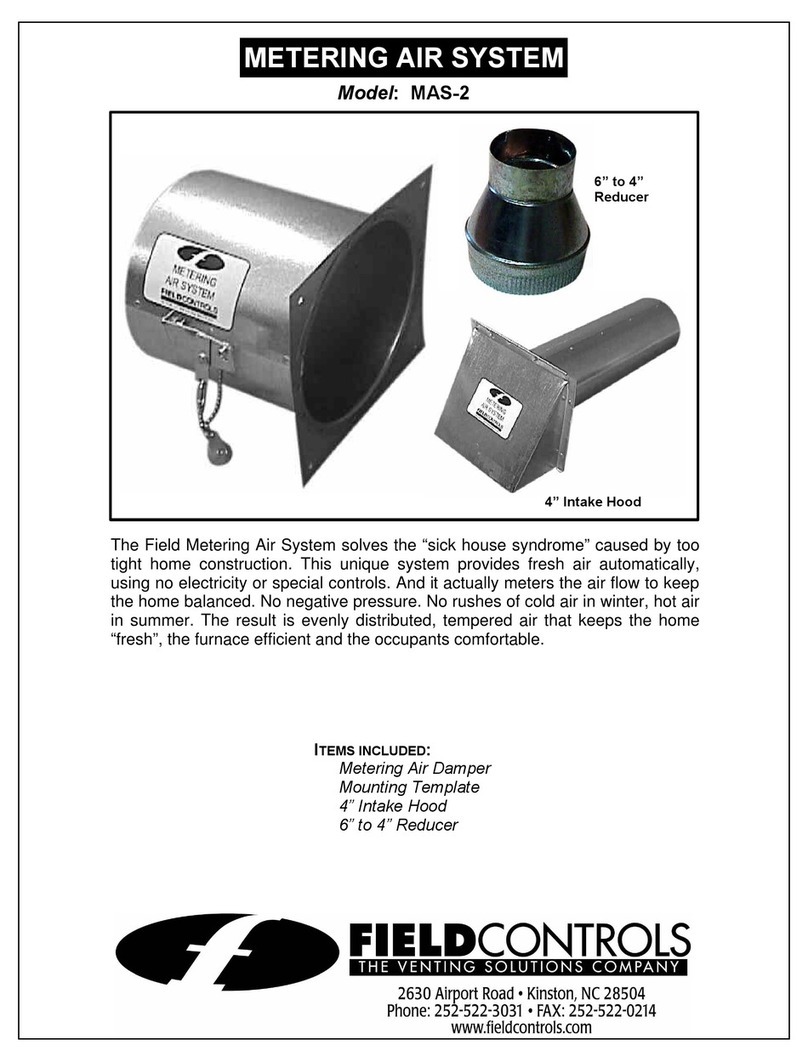
Field Controls
Field Controls 46384700 manual
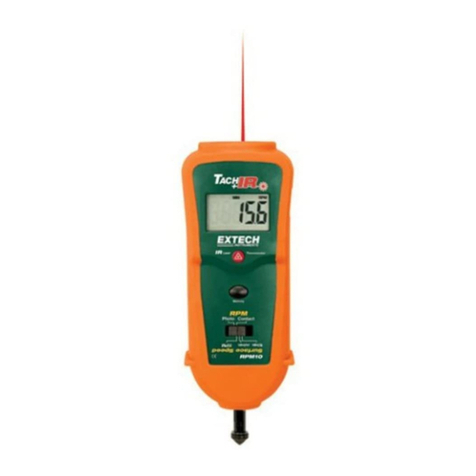
Extech Instruments
Extech Instruments RPM10 user guide
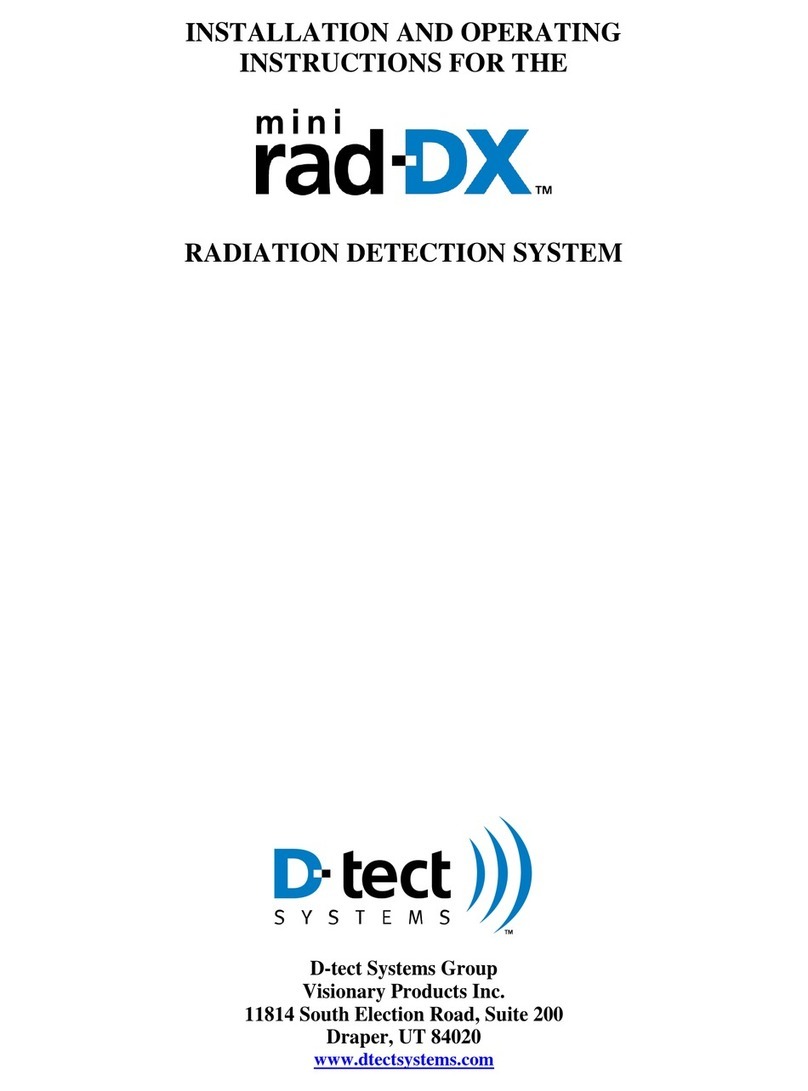
D-tect Systems
D-tect Systems MiniRad-DX Installation and operating instructions
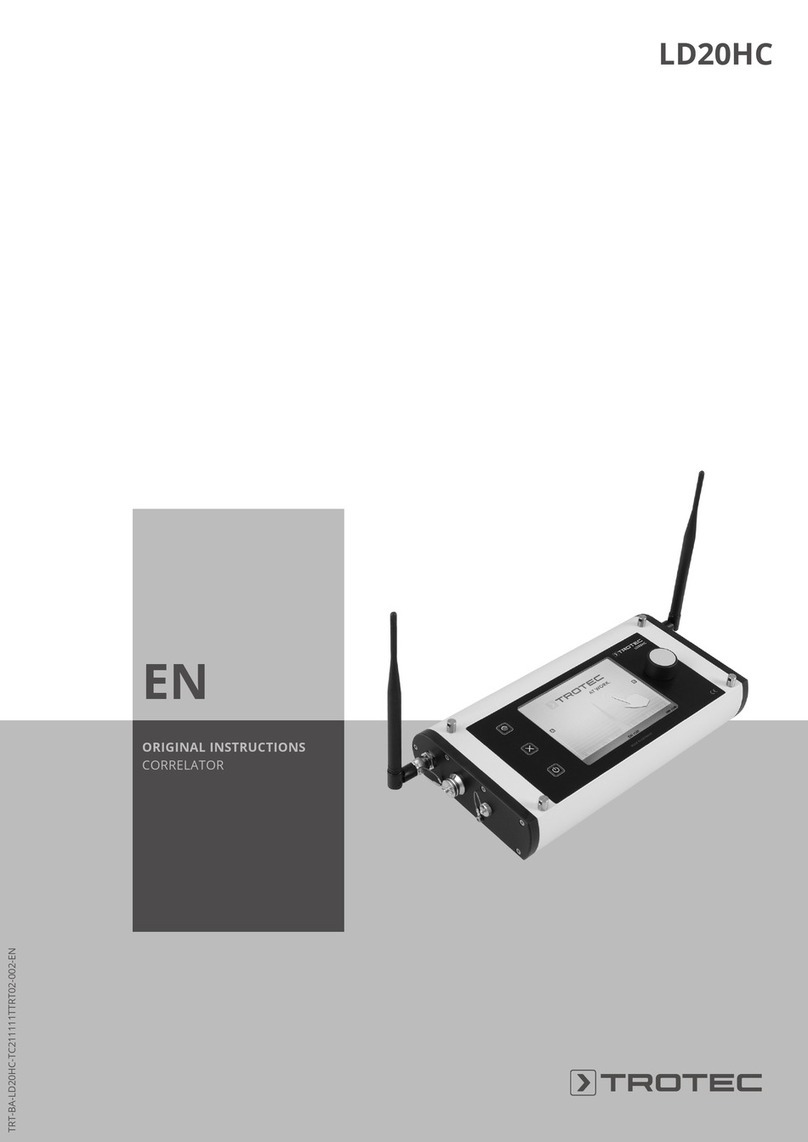
Trotec
Trotec LD20HC Original instructions

Bosch
Bosch GLM 40 Professional Original instructions
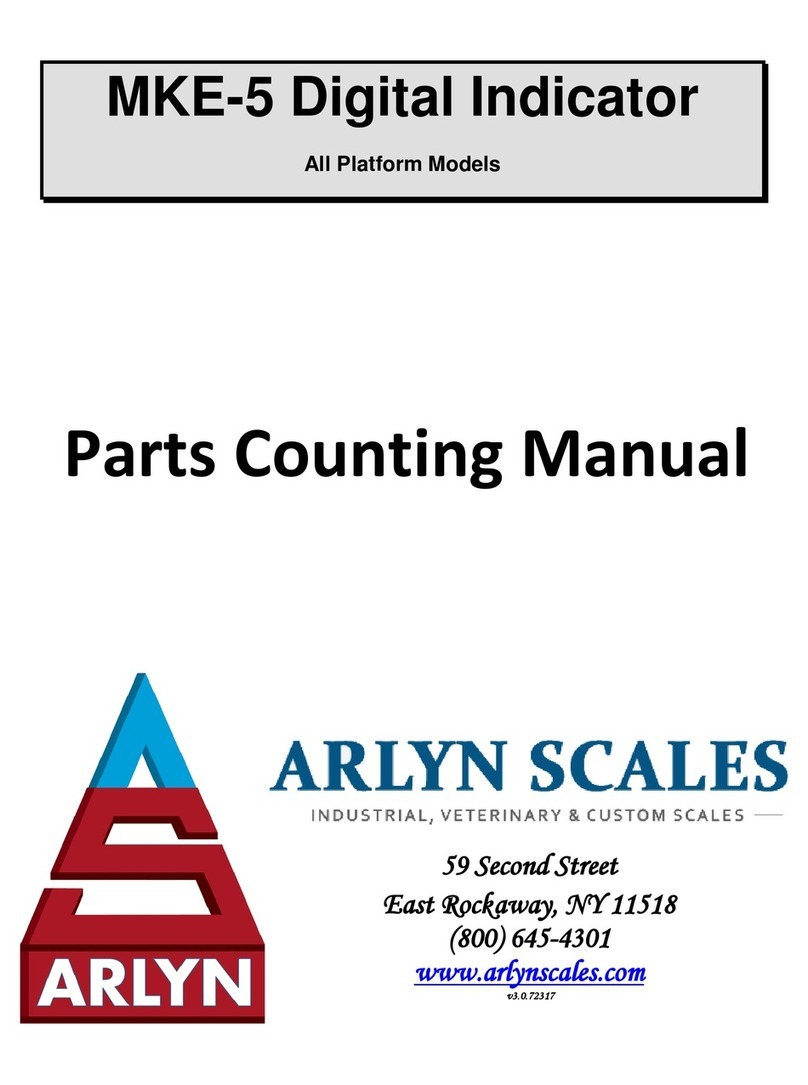
Arlyn Scales
Arlyn Scales MKE-5 manual
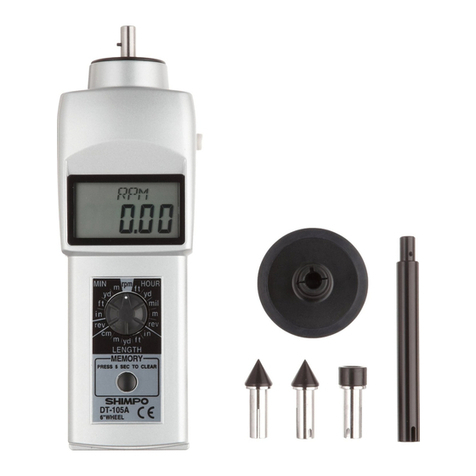
Shimpo Instruments
Shimpo Instruments DT-105A instruction manual
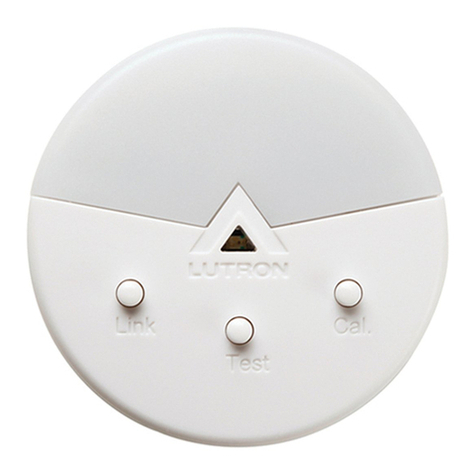
Lutron Electronics
Lutron Electronics Radio Powr Sav LRF2-DCRB Application note
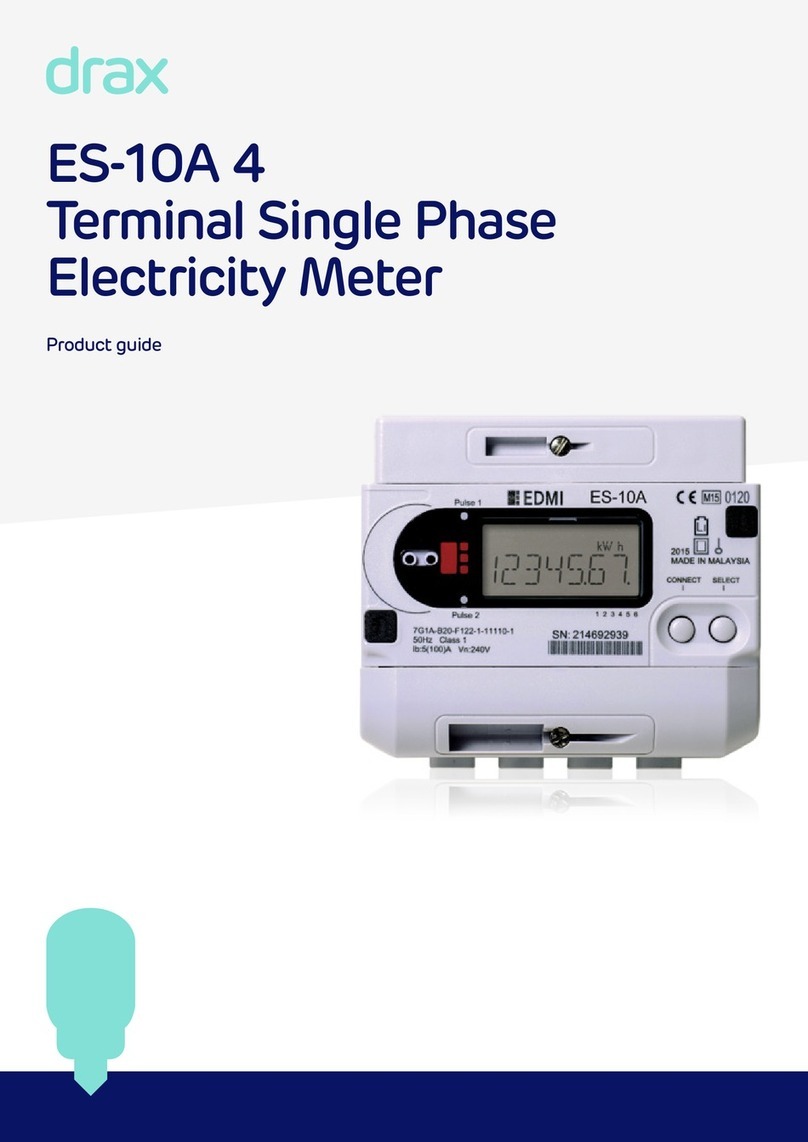
DRAX
DRAX ES-10A Product guide
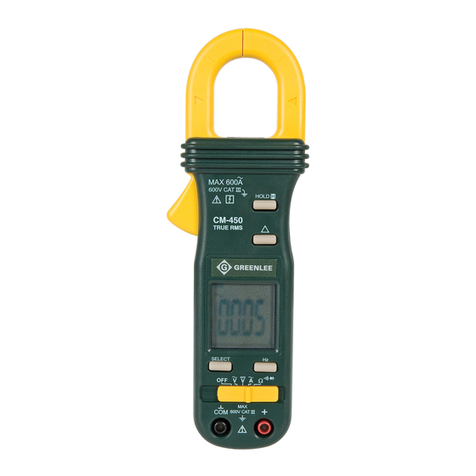
Textron
Textron Greenlee CM-450 instruction manual
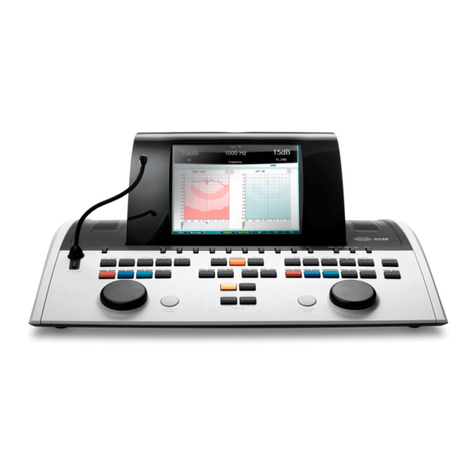
Interacoustics
Interacoustics AC40 Instructions for use
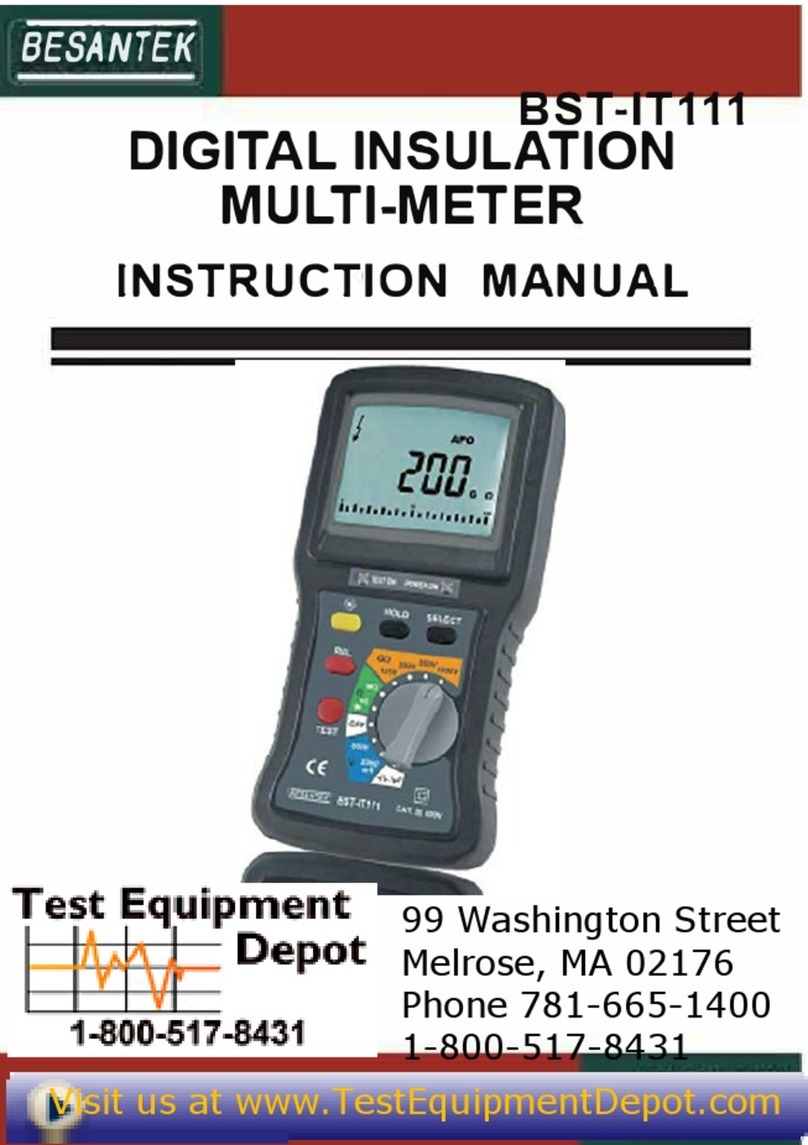
Besantek
Besantek BST-IT111 instruction manual
